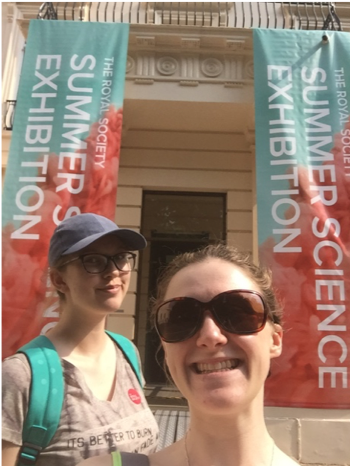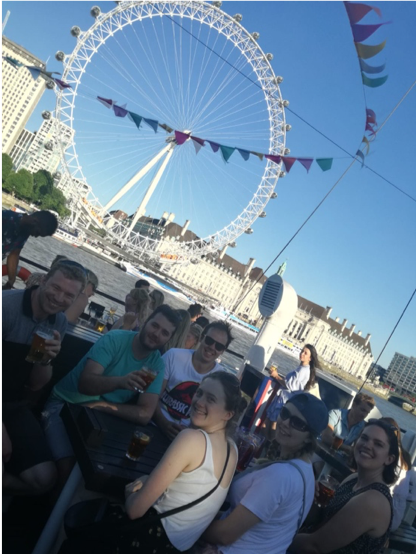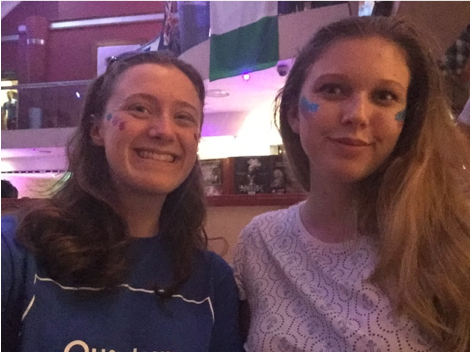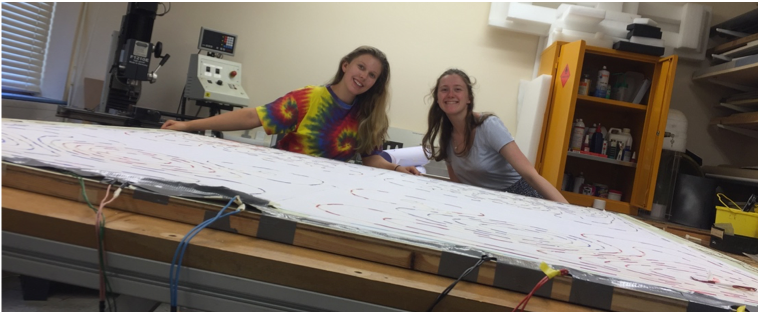July 27, 2018, by Dr. Meghan Gray
Eleanor and Lucy at the Royal Society Summer Science Exhibition

By Eleanor Hill and Lucy Edwards (3rd year MSci undergrads)
OUR TIME AT THE ROYAL SOCIETY
What is the Royal Society Summer Science Exhibition?
As two aspiring medical physicists, we were very excited to be a part of an exhibition showcasing ground-breaking developments in human brain scanning. It was astonishing to learn how a new, one of a kind, brain scanner relies upon fundamental quantum physics to detect brain activity. We joined the Sir Peter Mansfield Imaging Centre’s MEG group to help them present at the Royal Society Summer Science Exhibition in London. This is an exciting, week-long event that allows over 14,000 members of the public to chat to scientists and find out about cutting edge research!

Our stand, “Quantum Sensing the Brain”, aimed to show the public how we can use quantum sensors to detect magnetic fields generated by the brain. We wanted to demonstrate how this new system can have an impact on our understanding of the brain, specifically in debilitating mental health conditions.

Preparation
We spent our first two weeks constructing many parts of the exhibit, our favourite being the “Brain Room”. Here, we placed electrodes on someone’s head to detect electrical activity in their brain – we then connected these electrodes to a large-scale brain model, made from LEDs, which changed colour and intensity depending on what the person wearing the electrodes was thinking! The room was also filled with music, which also matched the person’s brain wave frequencies. This meant that visitors to the room could feel encapsulated inside the brain, and see and listen to a person’s brain waves in real time!

London!
The exhibition was open, at the Royal Society, for 7 days. On opening day, Brian Cox arrived to have his brain scanned! The American Ambassador also visited later in the week. For us, one of the greatest challenges throughout the week, besides the insane heat, was communicating and conveying complicated concepts to every single member of the public. We spoke to everyone from young children to university professors to MPs and Nobel prize winners. A wide breadth of topics were discussed, from the fundamental properties of atoms and quantum mechanics to mental health and the problems faced by those suffering from schizophrenia. It was a very steep learning curve, but it was so interesting to delve deep into the research being conducted. It was a lot of fun!

When we weren’t at the exhibit we had the opportunity to see what London has to offer. Visiting Buckingham palace, the London Eye, sunbathing in St James’s Park and experiencing London Pride were a cherry on top of the week.

Return to Nottingham
Returning to Nottingham was bittersweet. We were sad to be leaving the exhibit that we had worked so hard to create but excited to come back and start working with PhD student Niall Holmes. We helped Niall to construct a pair of coils for the new scanner. These act to null the Earth’s magnetic field, allowing the brain’s small magnetic fields to be detected.

This was a brilliant opportunity to be involved with cutting edge research and to go beyond the scope of what we have learnt in lectures. It was a real pleasure to get to know and work with our lecturers, PhD students and post-doctoral researchers. We can’t wait to see the advances made using this system and hopefully work with the team in the future!
No comments yet, fill out a comment to be the first

Leave a Reply